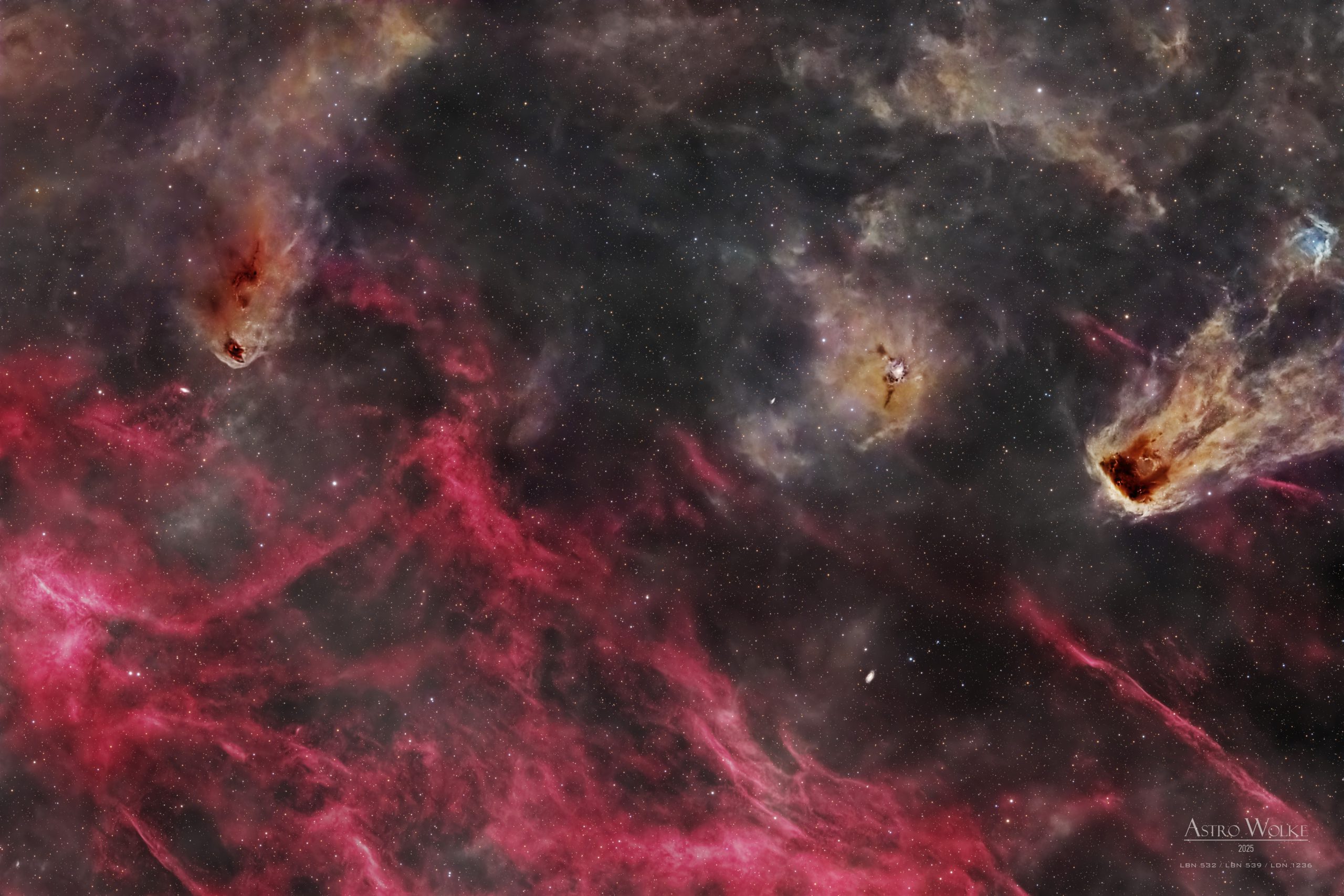LBN 532 / LBN 539 / LDN 1236
The celestial region in the constellation Cepheus presents a fascinating mosaic of dust and gas clouds: LBN 531, LBN 532, LBN 538, LBN 539, LDN 1235, and LDN 1236. At a distance of around 600 light-years, this area strikingly reveals the diversity of interstellar nebulae.
The bright nebulae LBN 532 (right) and LBN 539 (center) appear as faint reflection nebulae illuminated by nearby stars, while on the left side of the image the dark cloud LDN 1236 dominates. Together with LBN 531 (the Wolf’s Cave Nebula) and LDN 1235 (the Shark Nebula), they form one of the most remarkable regions of the northern Milky Way, where dark nebulae and reflection nebulae alternate in striking contrast.
In addition to dust and reflection nebulae, faint H-alpha emissions can also be detected here. These reveal regions of hydrogen gas excited by the radiation of young stars – a sign of ongoing or past star formation.
Die Himmelsregion im Sternbild Kepheus zeigt ein faszinierendes Mosaik aus Staub- und Gaswolken: LBN 531, LBN 532, LBN 538, LBN 539, LDN 1235 und LDN 1236. In rund 600 Lichtjahren Entfernung offenbart sich hier eindrucksvoll die Vielfalt interstellarer Nebel.
Die hellen Nebel LBN 532 (rechts), LBN 539 (Mitte) sind schwach leuchtende Reflexionsnebel, die durch das Licht benachbarter Sterne sichtbar werden, links im Bild die Dunkelwolke LDN 1236. Mit LBN 531 (Wolfshöhlen-Nebel) und LDN 1235 (Hai-Nebel), bilden diese Nebel eine der auffälligsten Regionen der nördlichen Milchstraße, in der sich Dunkelwolken und Reflexionsnebel kontrastreich abwechseln. Neben Staub- und Reflexionsnebeln finden sich hier auch schwache H-alpha-Emissionen. Diese zeigen, dass in Teilen der Region Wasserstoffgas durch die Strahlung junger Sterne zum Leuchten angeregt wird – ein Hinweis auf aktive oder zurückliegende Sternentstehung.
Total Integration: 40h 35’
Ha: 154x300s (12h 50’) 10./12.05.2025
L: 230x300s (19h 10’) 15.05./24.08./18./19./09.2025
L-RGB: 103x300s (8h 35’) – 19.09.2025
FOV: 3.3° x 2.2° (2°18′ x 2°12′)
Pixel scale: 1.9″/pixel
Dithering: 2 pixels every image
Gain: 100
Sensor temperature: 0°C
Recording: ZWO ASI 2600MM DUO / ZWO ASI 2600MC
Filter: Baader Luminance 2‘‘ / Baader SHO Ultra Narrowband 2‘‘
Optics: Askar SQA85 (mono) / TS Optics 76 EDPH (RGB)
Guiding: ASI 120 (ZWO OAG-L)
Mount: ZWO AM5N (mono) / Celestron AVX (RGB)
Control: ZWO ASIAIR Plus (mono) / ZWO ASIAIR MINI (RGB)
Software: PixInsight + Photoshop
Darks: 30
Flats: 20
Flat-Darks: 20


Comments are closed